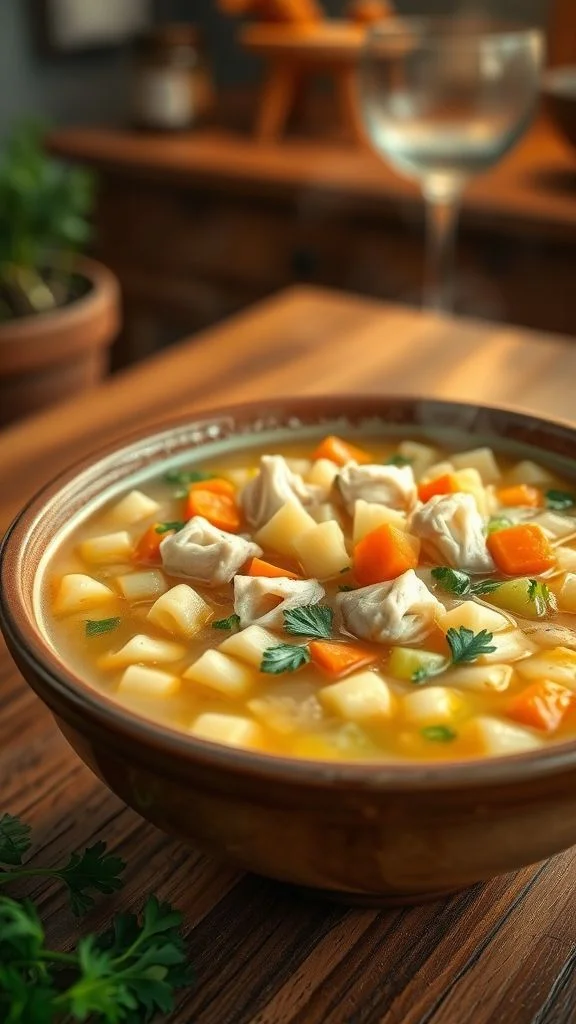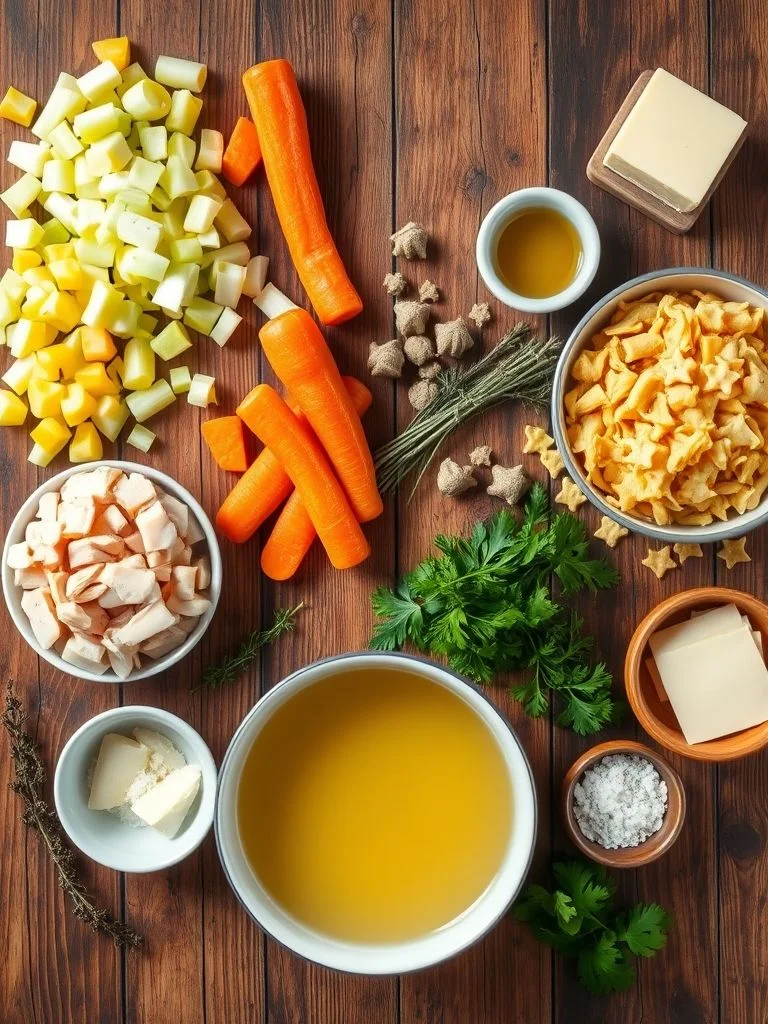
Why Chicken Pastina Soup is the Perfect Comfort Food
When autumn winds begin to whisper and winter’s chill settles in, nothing compares to the soul-warming embrace of authentic Italian chicken pastina soup. This beloved dish, affectionately known as “Italian Nonna’s Penicillin,” has been nurturing families for generations with its perfect harmony of tender chicken, aromatic broth, and tiny star-shaped pasta.
More than just a meal, chicken pastina soup represents the essence of Italian home cooking – simple ingredients transformed into something magical through love, tradition, and time-honored techniques.
Table of Contents
What Makes Chicken Pastina Soup So Special?
The History Behind Italy’s Healing Soup
Chicken pastina soup traces its roots deep into Italian culinary tradition. Pastina, meaning “little pasta” in Italian, has been a staple in Italian households since the early 1900s. Originally created as a gentle, easily digestible meal for children and the elderly, this soup quickly became a family favorite across all age groups.
The nickname “Italian Penicillin” isn’t just poetic – it’s backed by centuries of Italian mothers who understood the healing power of warm, nutritious broth combined with simple, wholesome ingredients.
Health Benefits That Make a Difference
Nutritional Powerhouse: Each bowl of chicken pastina soup delivers:
- High-quality protein from tender chicken (supporting muscle health and immune function)
- Complex carbohydrates from pastina pasta (providing sustained energy)
- Essential vitamins and minerals from vegetables (boosting overall wellness)
- Hydrating broth that helps maintain fluid balance
- Anti-inflammatory properties from garlic and herbs
Digestive Wellness: The small pasta size makes this soup incredibly easy to digest, perfect for:
- Recovery from illness
- Sensitive stomachs
- Children and elderly family members
- Cold and flu season support
Essential Ingredients for Authentic Chicken Pastina Soup
The Star: Understanding Pastina Pasta
What is Pastina? Pastina encompasses various tiny pasta shapes, each bringing its own character to the soup:
- Stelline (Stars): The classic choice, perfect for capturing broth
- Acini di Pepe: Tiny round balls that add delightful texture
- Orzo: Rice-shaped pasta that creates a heartier feel
- Farfalline: Mini bow ties for visual appeal
- Ditalini: Small tubes that hold flavor beautifully
Premium Ingredients for Maximum Flavor
The Perfect Chicken:
- Rotisserie chicken (time-saving and flavorful)
- Chicken thighs (more tender and juicy than breasts)
- Leftover roasted chicken (excellent for reducing waste)
Aromatic Vegetables:
- Yellow onions (sweet and mild when cooked)
- Carrots (natural sweetness and beautiful color)
- Celery (classic mirepoix base)
- Fresh garlic (immune-boosting and aromatic)
Liquid Gold – The Broth:
- Low-sodium chicken broth (controls salt content)
- Homemade chicken stock (ultimate flavor depth)
- Bone broth (extra nutritional benefits)
Step-by-Step Recipe: Perfect Chicken Pastina Soup Every Time

Ingredients (Serves 6-8):
- 2 tablespoons olive oil
- 1 tablespoon butter
- 1 large yellow onion, diced
- 3 medium carrots, diced small
- 3 celery stalks, diced small
- 4 garlic cloves, minced
- 8 cups low-sodium chicken broth
- 2 cups cooked chicken, shredded
- 1 cup pastina (stelline or acini di pepe)
- 2 bay leaves
- 1 teaspoon dried thyme
- Salt and black pepper to taste
- Fresh parsley for garnish
- Grated Parmesan cheese (optional)
Cooking Instructions:
Step 1: Create the Flavor Base (5 minutes) Heat olive oil and butter in a large Dutch oven over medium heat. Add diced onions, carrots, and celery. Sauté until vegetables begin to soften, about 4-5 minutes. Add minced garlic and cook for another 30 seconds until fragrant.
Step 2: Build the Broth (15 minutes) Pour in chicken broth and add bay leaves and thyme. Bring to a gentle boil, then reduce heat and simmer for 10-15 minutes until vegetables are completely tender.
Step 3: Add the Stars (10 minutes) Stir in pastina and cooked chicken. Simmer for 8-10 minutes, stirring occasionally, until pasta is al dente. The pastina will continue to absorb liquid and expand.
Step 4: Perfect the Seasoning (2 minutes) Remove bay leaves and season with salt and pepper to taste. Let soup rest off heat for 5 minutes to allow flavors to meld.
Step 5: Serve with Love Ladle into warm bowls and garnish with fresh parsley and grated Parmesan cheese if desired.
Pro Chef Tips for Restaurant-Quality Results
Texture Perfection
- Don’t overcook the pastina – it should be slightly firm as it continues cooking in hot broth
- For thicker soup: Use an immersion blender to partially puree some vegetables
- For lighter consistency: Add additional warm broth just before serving
Flavor Enhancement Secrets
- Parmesan rind magic: Add a Parmesan rind to the simmering broth for deeper, nuttier flavor
- Herb oil finish: Drizzle with herb-infused olive oil before serving
- Lemon brightness: A squeeze of fresh lemon juice brightens the entire dish
Make-Ahead Mastery
Storage Strategy: Store pasta and broth separately to prevent mushy texture
- Broth: Refrigerate up to 4 days or freeze up to 3 months
- Cooked pastina: Store separately in refrigerator for up to 3 days
- Reheating: Combine gently over low heat, adding fresh broth if needed
Creative Variations to Customize Your Soup
International Fusion Twists
- Mediterranean Style: Add diced tomatoes, olives, and fresh basil
- Asian-Inspired: Include ginger, green onions, and a splash of soy sauce
- Mexican Influence: Incorporate jalapeños, corn, and cilantro
Dietary Adaptations
- Gluten-Free: Use rice pastina or small rice shapes
- Vegetarian/Vegan: Replace chicken with white beans and use vegetable broth
- Keto-Friendly: Substitute pastina with cauliflower rice
- Paleo Version: Use spiralized vegetables instead of pasta
Serving Suggestions and Presentation Ideas
Garnish Like a Pro
- Fresh herbs: Chopped parsley, thyme, or chives
- Cheese options: Freshly grated Parmesan, Pecorino Romano, or aged cheddar
- Texture additions: Crispy pancetta bits, toasted pine nuts, or homemade croutons
- Oil drizzles: Extra virgin olive oil or truffle oil for luxury
Perfect Pairings
- Bread companions: Crusty Italian bread, focaccia, or garlic breadsticks
- Wine selections: Light Pinot Grigio, Chianti Classico, or Soave
- Side salads: Simple arugula with lemon vinaigrette or classic Caesar
Nutritional Information and Health Benefits
Per Serving Breakdown:
- Calories: Approximately 180-220
- Protein: 15-18g (excellent for muscle maintenance)
- Carbohydrates: 20-25g (sustained energy)
- Fat: 6-8g (heart-healthy when using olive oil)
- Fiber: 2-3g (digestive health)
- Sodium: 600-800mg (varies with broth choice)
Immune-Boosting Properties
- Chicken protein: Supports antibody production
- Warm broth: Helps clear congestion and maintains hydration
- Garlic and onions: Natural antimicrobial properties
- Vegetables: Provide essential vitamins A, C, and K
Troubleshooting Common Issues
Problem-Solution Guide
Pasta becomes mushy:
- Cook pastina separately and add just before serving
- Use less pasta initially – it expands significantly
Soup too thin:
- Create a slurry with cornstarch and cold water
- Blend a portion of the vegetables for natural thickening
Lacks flavor:
- Season in layers throughout cooking
- Add acid (lemon juice) to brighten flavors
- Include fresh herbs at the end
Too salty:
- Add diced potatoes to absorb excess salt
- Dilute with additional low-sodium broth
- Balance with a touch of cream or butter
Cultural Significance and Family Traditions
The Italian Connection
In Italian culture, pastina in brodo (pastina in broth) represents more than sustenance – it embodies care, healing, and family bonds. Traditional Italian mothers prepare this soup not just for nutrition, but as an expression of love and comfort.
Creating New Traditions
Whether you’re continuing a family recipe or starting a new tradition, chicken pastina soup offers the perfect opportunity to:
- Bond with family through cooking together
- Teach children about wholesome, homemade meals
- Create comfort during difficult times
- Celebrate heritage and cultural connections
Seasonal Adaptations and Year-Round Enjoyment
Fall and Winter Warmth
- Heartier versions: Add root vegetables like parsnips and turnips
- Warming spices: Include a pinch of red pepper flakes or fresh cracked black pepper
- Richer broths: Use bone broth for extra warmth and nutrition
Spring and Summer Lightness
- Fresh vegetables: Incorporate zucchini, peas, or fresh tomatoes
- Herb abundance: Use fresh basil, oregano, and Italian parsley
- Lighter preparation: Reduce pasta quantity for a brothier consistency
Conclusion: Your Journey to Soup Perfection
Chicken pastina soup represents the beautiful intersection of simplicity and sophistication, tradition and innovation. This versatile dish adapts to your needs while maintaining its essential character – a warm, nurturing bowl of comfort that speaks to the soul.
Whether you’re battling a cold, celebrating a family gathering, or simply craving the ultimate comfort food, this recipe provides the foundation for countless delicious variations. The key lies in using quality ingredients, respecting the cooking process, and infusing each bowl with love and care.
Remember, the best chicken pastina soup isn’t just about following a recipe – it’s about creating memories, nourishing loved ones, and continuing a beautiful culinary tradition that has warmed hearts for generations.
Start your chicken pastina soup journey today and discover why this humble dish has earned its place as one of the world’s most beloved comfort foods. Your family will thank you, your taste buds will celebrate, and your soul will find the comfort it seeks in every warming spoonful.
Have you tried making chicken pastina soup? Share your variations and family traditions in the comments below – we’d love to hear how you make this classic recipe your own!
“Last updated on June 24, 2025 to include the latest information.”
